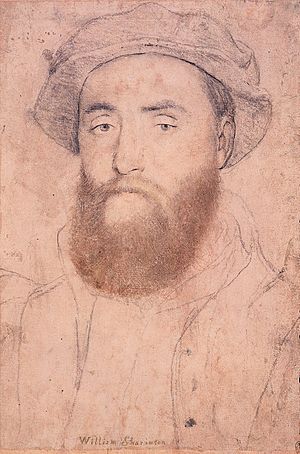William Sharington facts for kids

Sir William Sharington (born around 1495, died before July 6, 1553) was an important English courtier during the time of King Henry VIII. He was in charge of the Bristol Mint, served as a member of parliament, and was also High Sheriff of Wiltshire.
Contents
Early Life and Interests
William Sharington was the oldest son of Thomas Sharington, a gentleman from Norfolk. His mother was Katherine Pyrton. When he was young, William traveled to Italy. This trip made him very interested in art and design.
His father left him some land in Norfolk in 1519, which William later sold in 1532. This land had been in his family for a long time, coming from his great-grandfather who was a steward to the Bishop of Ely.
Working for the King
Sharington's early career is not very well known. He married Ursula, who was the daughter of Lord Berners, a friend of his. By 1538, William was working for Sir Francis Bryan, a soldier and diplomat. This is how he became friends with Thomas Seymour. Thomas Seymour was the brother of Jane Seymour, who became King Henry VIII's third queen in 1536.
By 1539, William Sharington was working for the king directly. He started as a page in charge of the king's robes and was later promoted to Groom of the Robes in 1540. The king trusted him, and he continued to get more important jobs in the Privy chamber by 1542. Also in 1542, he became the steward of Castle Rising in his home county of Norfolk. In 1544, he joined the household of Queen Catherine Parr.
Building and Buying Land
In 1540, after the king closed down many monasteries (called the dissolution of the Monasteries), Sharington bought Lacock Abbey in Wiltshire for £783. He started to turn the abbey into his private home. He was very good at design and kept many of the old parts of the building. He added a tall, eight-sided tower, fancy chimneys, and a stable area. He also designed new buildings at Dudley Castle for his friend John Dudley. These buildings are still known as the Sharrington Range.

In 1541, Sharington rented the manor of Heytesbury in Wiltshire from the king. This made him a very powerful person in that area. He began to buy a lot of land. By 1548, he owned fourteen manors in Wiltshire and others in nearby counties.
Serving in Parliament
William Sharington became a member of parliament for Heytesbury in 1545. He also represented Bramber in 1547. He was made a knight at the crowning of King Edward VI on February 20, 1547. In the same year, he became one of the two knights of the Shire for Wiltshire.
Business and the Mint
Besides owning land, Sharington was a merchant and had several ships that traded from Bristol. He bought wool from all over Wiltshire and also lent money to people.
In 1546, Sharington became the under-treasurer of a new mint in Bristol Castle. This job was like being the master of the mint. It paid him a good salary. The Bristol mint was special because it was the only one outside London that made gold coins. It also made coins for Ireland.
In 1547, Sharington was asked to join special groups (called commissions) to check on the king's mints and the navy. He also served as a Justice of the Peace for Wiltshire, helping to keep law and order.
Challenges and Pardon
By 1548, Sharington faced problems at the Bristol mint. He made coins that were not as valuable as they should have been and made more coins than he was supposed to. He kept false records to hide what he was doing. He later said he was worried about losing money and the high costs of rebuilding Lacock Abbey.
He became involved with Thomas, Lord Seymour, who was planning to challenge the government. Sharington agreed to provide money for Seymour's plans. However, their plans were discovered. In January 1549, both men were arrested. Sharington confessed and blamed Seymour. As a result, Sharington lost his land and his seat in parliament. Seymour was executed.
Even though he lost his land, Sharington was helped by powerful friends like Francis Talbot, 5th Earl of Shrewsbury and Thomas Wriothesley, 1st Earl of Southampton. He also got help from Hugh Latimer, a famous preacher, who spoke kindly about him to the king. In November 1549, Sharington was pardoned. After paying a large sum of money (£12,867), he got his estates back.
Later Service
In April 1550, Sharington was chosen to travel to France with Sir Maurice Dennis. Their job was to bring back two hundred thousand crowns, which was part of the payment for the sale of Boulogne to Henry II of France. He continued to serve as a magistrate. In October 1551, he became a member of parliament again for Wiltshire. In 1552, he was appointed Sheriff of Wiltshire.
Family and Death
William Sharington was married three times. His first wife was Ursula. After she died, he married Eleanor Walsingham, who was the sister of Sir Francis Walsingham. His third wife was Grace Farrington. However, William Sharington did not have any children.
He died sometime before July 6, 1553. His estates were passed on to his brother, Henry Sharington.
Portrait
A drawing of Sir William Sharington was made by the famous artist Hans Holbein the Younger. This drawing was bought by King Charles II in 1675 and is now kept in the Royal Collection at Windsor Castle. The drawing shows "William Sharinton" and is made with black and colored chalks.
Mint Mark
Some of the coins made at the Bristol mint when Sharington was in charge have a special mark. This mark is a combination of the letters "W. S." (for 'William Sharington') and can be seen on some gold coins from the time of Henry VIII.

